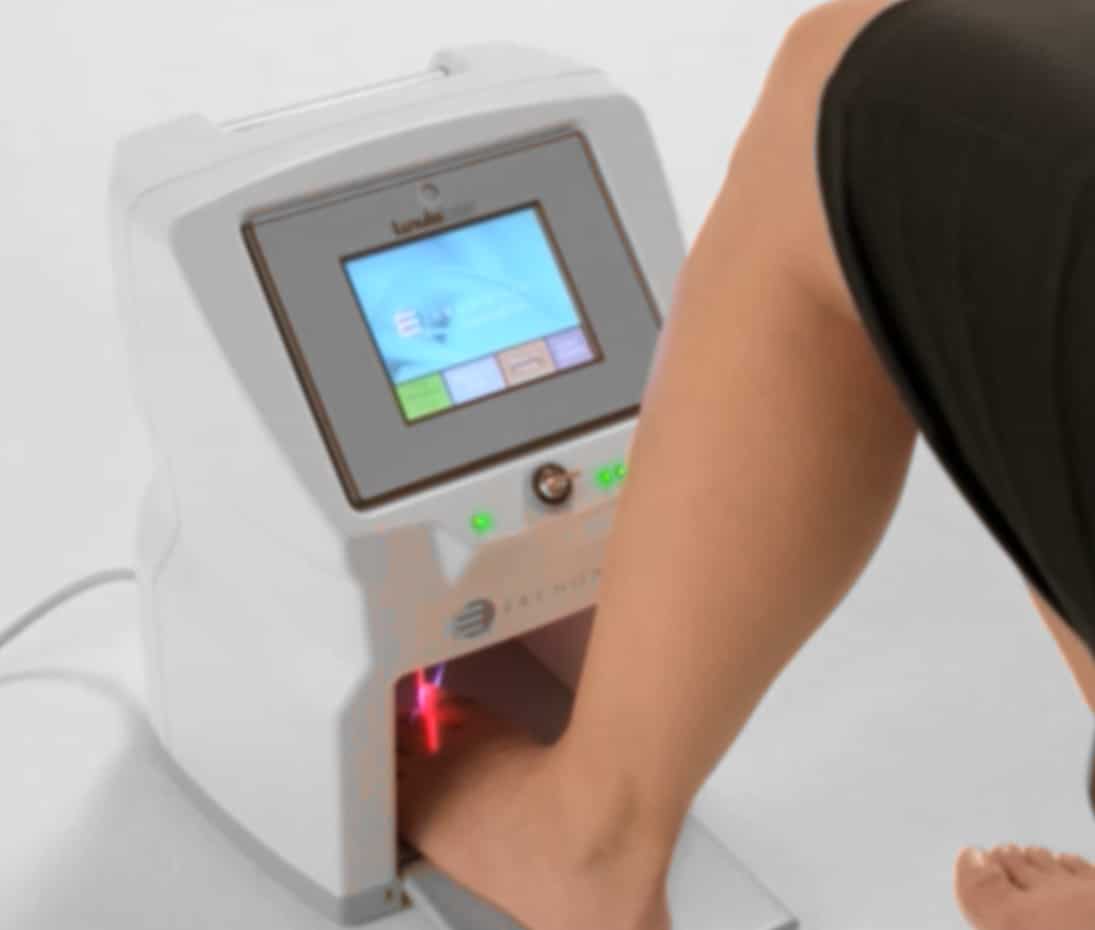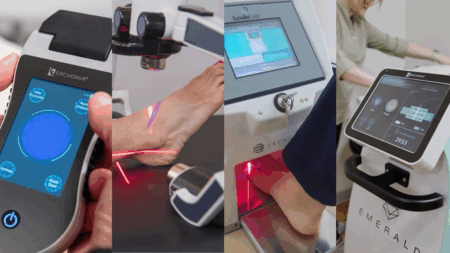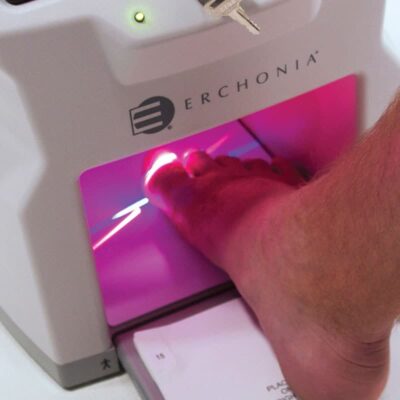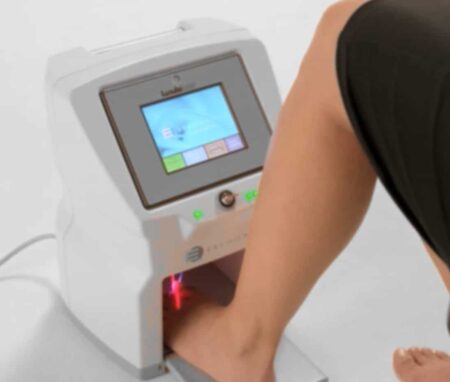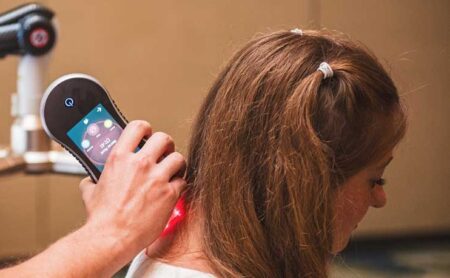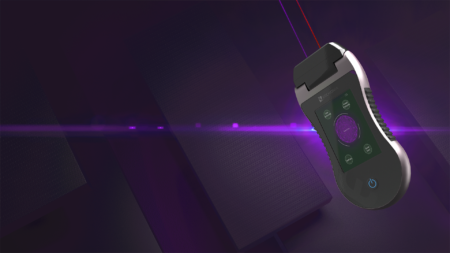The use of Lunula cold laser has quickly become the #1 preferred treatment to eliminate both mild, severe and stubborn fungal nail infections over the past decade. For the patient, Lunula boasts significant benefits including being completely painless and heat free, eliminating the risk of burns and discomfort experienced with traditional hot laser. Having no side effects and being the first and only non-thermal laser to receive FDA market clearance for treating onychomycosis, it removes the hassle of having to apply products daily to the toenails in the hopes of being in the 5.5% to 17.8% who see results, or having to add to a person’s daily medications list with potential side effects and complete cure rates of only 14%-38%.
For clinics and practitioners, Lunula laser makes the treatment process easy, simple and reliable, with the entire process aside from inserting the feet automated and completed in just 12 minutes per foot. During this time, the laser acts on the entire foot and all the nails, and the practitioner is free to answer questions, discuss reinfection prevention protocols and complete clinical notes. With patient satisfaction rates of 93% [1] to best support a clinic’s reputation and word of mouth referrals, cold laser has also demonstrated clinical cure and mycological cure rates of 70% and 95% respectively, with figures rising to 90% and 95% by 12 months, and with 100% of study participants having new unaffected nail growth [2]. Other studies conducted using strict protocols by the laser manufacturers have confirmed individual success rates to be as high as 86% at week 12, extending to 99% by week 48 [3]. Even in severely affected toenails where 81% of the toenail on average was affected by fungus, 63.6% of toenails reached full clearance [4].
With a fantastic reputation for its efficacy, safety and ease of use in managing fungal infections, there’s a point of interest that may practitioners have also picked up on from using the Lunula laser in their clinic, from their own experience and the feedback from their patients: Lunula laser may have far more benefits than first meets the eye.
The Unexpected Benefits Of Lunula Laser
The additional benefits of laser come about due to the laser’s unique dual action mechanism that simultaneously uses two heat-free beams of 405nm and 635nm respectively. These support Lunula’s antifungal actions by the blue wavelength (405nm) significantly weakening the outer wall of the fungal cells by causing irreversible damage, while the red (635nm) wavelength strengthens the body’s immune cells to act on the fungus, while also improving blood flow to the area to accelerate the clearance process.
Interestingly, these exact two wavelengths are also used by the EVRL laser, made by the same parent company and the world leader in low-level laser technology for a range of physicians and practitioners, Erchonia. The EVRL, which has FDA market clearance for the relief of musculoskeletal pain, as well as clearance by the ISO, CE and EIC. Here, the two laser wavelengths work on the area directly over which it is applied to enable cells to use the emitted light energy for healing, pain-relieving, anti-inflammatory and reparative functions, with studies showing better results by this dual-laser combination compared to other pain relieving lasers on the market using just a single beam.
So What Benefits Can Podiatric Patients Stand To Gain?
While Lunula laser only has FDA clearance for its antifungal effects in treating onychomycosis, potential side effects that may be reported based on its core mechanism of action may include temporary relief from arthritic pain from osteoarthritis, rheumatoid arthritis or gout, particularly in the big toes and feet given its key application site. For the EVRL laser, it’s pain-relieving and anti-inflammatory properties have seen results including: [5, 6, 7, 8]
- A 70% pain reduction with low-level laser compared to placebo
- Reduction in morning joint stiffness by 27.5 minutes
- Improved flexibility and performance
- Significant reductions in disability and pain, with pain reduction peaking during follow-ups 2-4 weeks after finishing the therapy program in the studies
Additionally, low level laser has also been studied in wound healing compared to sham treatments, to find that the group treated with laser had smaller wounds for both specifically targeted and untargeted wounds, as early as 6 days after laser treatment [9, 10]. With wounds being among the most common health problems worldwide and being associated with increased morbidity, this can create a powerful potential benefit for patients, even if it is not associated with the goal of the treatment.
Similarly, low level laser has also shown improvements in tissue scars resulting from surgery, through promotion, fortification, and commissioning of the cellular cycle to generate productive and substitute cells. Specifically, low low-level laser can affect enzymatic chain reactions, cellular immunity, the quantity and quality of immune cells, cell proliferation process, tissue secretions- and all without adverse effects [11].
Low level laser may also support the healing and repair of damaged tissues, if patients are dealing with concurrent injuries in the treatment area. Photons of light from low level laser at the wavelengths emitted by Lunula penetrate to help accelerate cellular reproduction and growth, while increasing the cell (ATP) energy production so that they can take on nutrients faster and get rid of waste products. As a result of exposure to laser light, all cells, including the cells of tendons, ligaments, and muscles, are repaired at a faster rate. Adding to this, low-level laser is also shown to notably increase the formation of new capillaries in damaged tissue which can support the healing process, alongside its vasodilatory effects which can improve the delivery of blood and healing elements to damaged tissues. These vasodilatory effects also promote the reduction of inflammation in the feet.
Finally, low-level laser including the EVRL are also noted to have beneficial effects on a person’s nerve function in the targeted areas, where damaged nerves are present. Specifically, low level laser is shown to speed up the process of axonal regeneration and nerve cell reconnection, and increase the amplitude of action potentials to optimise muscle action.
EVRL Laser: The Full Suite Of Benefits
Looking at the EVRL laser for a moment, it is currently being used by a wide range of practitioners globally for conditions including sprains, whiplash, muscular pain, cervical or lumbar radiculopathy, tendinitis, and carpal tunnel syndrome. EVRL has also shown positive effects on those with arthritis in other areas of the body, in the management of post-surgical pain, neuropathic pain, pain management for athletes recovering from training or injuries – and even for bacterial infections. You can learn more about the EVRL laser and its full suite of benefits here.
Lunula Laser: The Bigger Picture
While the primary goal and mechanism of action of the Lunula laser is to safely and effectively treat fungal nail infections and it cannot be marketed for any other potential benefits it may have to patients, it can feel extremely reassuring as a health professional to know that the antifungal therapy you’re using is also being used in a range of other modalities to produce a wide range of beneficial effects that may potentially present throughout your patient’s antifungal treatment – even without them realising.
To learn more about the Lunula laser, contact Rehacare on 1300 653 522 or at info@rehacare.com.au.
- [1]: https://www.opnassociation.ca/wp-content/uploads/2019/09/Sullivan_Erchonia-Laser-Therapy-in-the-Treatment-of-Onychomycosis-Preliminary-Report_Podiatry-Review-Vol-71.2_03_14.pdf
- [2]: https://www.peertechzpublications.com/articles/IJDCR-7-140.php
- [3]: https://www.coldlasernailclinic.nz/wp-content/uploads/2018/03/ERCHONIA-LUNULA-Toenail-Onychomycosis-Clinical-Study-Results-Report-FDA-3.docx
- [4]: https://www.podiatrym.com/pdf/2017/1/Tumolo117web.pdf
- [5]: https://pubmed.ncbi.nlm.nih.gov/10955339/
- [6]: https://bmjopen.bmj.com/content/9/10/e031142
- [7]: https://pubmed.ncbi.nlm.nih.gov/10955339/
- [8]: https://www.nature.com/articles/s41598-022-26553-9
- [9]: https://www.ncbi.nlm.nih.gov/pmc/articles/PMC522143/
- [10]: https://www.mdpi.com/2304-6732/9/8/591
- [11]: https://biomedpharmajournal.org/vol8no2/low-level-laser-therapy-for-the-treatment-of-chronic-wound-clinical-considerations/

